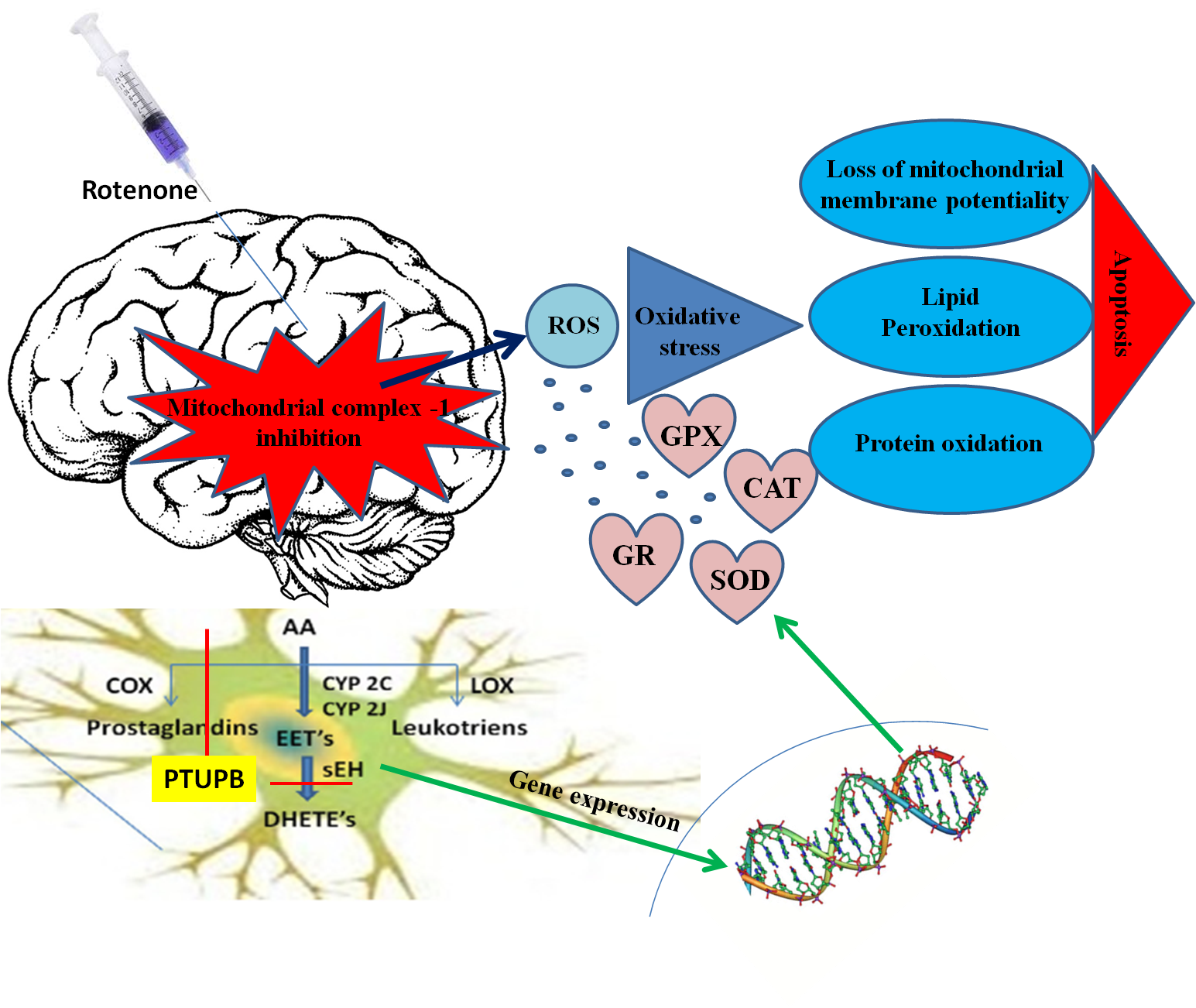Session Information
Date: Thursday, June 8, 2017
Session Title: Other
Session Time: 1:15pm-2:45pm
Location: Exhibit Hall C
Objective: To evaluate the potential anti-parkinson activity of PTUPB (4-(5-phenyl-3-{3-[3-(4-trifluoromethyl-phenyl)-ureido]-propyl}-pyrazol-1-yl)-benzenesulfonamide) a dual inhibitor of soluble Epoxide hydrolase (sEH) and cyclooxygenase-2 (COX-2) against rotenone induced mitochondrial dysfunction, oxidative stress and neuroinflammation in N27 dopaminergic cell lines and Drosophila melanogaster.
Background: The metabolites of arachidonic acid cascade such as epoxyeicosatrienoic acids (EETs), is reported to play a crucial role in cytoprotection, due to their ability to attenuate oxidative stress, inflammation, and apoptosis. However EETs are subjected to rapid in vivo metabolism by sEH. The progressive neuroinflammation induces the release of COX-2 which is rapidly expressed in several cell types in response to cytokines, and pro-inflammatory mediators. The potential downstream toxic effects of COX-2 are further increase in progression of inflammation and oxidative stress via production of oxidizing reactive species during the peroxidase activity. Therefore, one of the novel strategy is inhibition of both sEH and COX-2 (Fig 1).
Methods: Cytoprotective role of PTUPB was confirmed in N27 cells against rotenone (400nM) treatment by MTT and LDH release assays. Further, total intracellular ROS, protein oxidation, lipid peroxidation, mitochondrial membrane potential, antioxidant, anti-inflammatory, and anti-apoptotic status was evaluated as per the standard protocols. Further, in vivo neuroprotective ability of PTUPB was confirmed against rotenone induced toxicity in Drosophila. Survival rate, negative geotaxis, antioxidant status, dopamine level was evaluated as per the standard protocols.
Results: Our results indicated that PTUPB pre-treatment significantly improved cell viability as confirmed by cytotoxicity assays. Further, neuroprotective role of PTUPB was associated with amelioration of ROS production, proteins oxidation and lipids peroxidation against rotenone induced toxicity. PTUPB also significantly protect the mitochondrial damage and improved the enzymatic antioxidant, anti-inflammatory, anti-apoptotic status which was declined with rotenone treatment in both N27 cell line and Drosophila model of PD.
Conclusions: These results substantiate the neuroprotective effect of PTUPB indicating its potential therapeutic benefits in the treatment of PD.
References: 1. G. Zhang, D. Panigrahy, S.H. Hwang, et al., Dual inhibition of cyclooxygenase-2 and soluble epoxide hydrolase synergistically suppresses primary tumor growth and metastasis, Proceedings of the National Academy of Sciences 111 (2014), pp. 11127-11132.
2. N. Lakkappa, P.T. Krishnamurthy, B.D. Hammock, D. Velmurugan and M.S. Bharath, Possible role of Epoxyeicosatrienoic acid in prevention of oxidative stress mediated neuroinflammation in Parkinson disorders, Medical Hypotheses 93 (2016), pp. 161-165.
To cite this abstract in AMA style:
N. Lakkappa, P. Thaggikuppe Krishnamurthy, P.D. Mirazkar, N. Lakkappa, P. Krishnamurthy, P.M.D., M.M. Srinivas Bharath, B. Hammock, S.H. Hwang. Neuroprotective propensity of PTUPB, a dual inhibitor of sEH and COX-2 against rotenone induced neurotoxicity in cell line and Drosophila model of Parkinson disease [abstract]. Mov Disord. 2017; 32 (suppl 2). https://www.mdsabstracts.org/abstract/neuroprotective-propensity-of-ptupb-a-dual-inhibitor-of-seh-and-cox-2-against-rotenone-induced-neurotoxicity-in-cell-line-and-drosophila-model-of-parkinson-disease/. Accessed March 31, 2025.« Back to 2017 International Congress
MDS Abstracts - https://www.mdsabstracts.org/abstract/neuroprotective-propensity-of-ptupb-a-dual-inhibitor-of-seh-and-cox-2-against-rotenone-induced-neurotoxicity-in-cell-line-and-drosophila-model-of-parkinson-disease/

